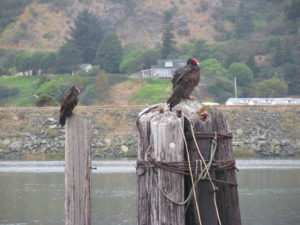THE CREATION IS ENGINEERED – NOT EVOLVED!
Vultures are birds of prey like osprey and eagles with sharp hooked beaks. However, they are not predators, but are primarily carrion feeders designed to eat dead animal carcasses. All vultures share the characteristic of a bald head with the designed purpose of keeping unwanted residue of the vulture’s meal off its head and neck. This precludes a buildup of nasty bacteria on the vulture as it dives in for its meals.
The Turkey Vulture (Cathartes aura) has weak talons and a thin beak which restricts it to eating rotting flesh or decaying vegetables. Amazingly its digestive tract is engineered to destroy deadly bacteria in the food it eats. The bird’s excrement also kills the bacteria as it falls on the vulture’s feet and body.
Image of Turkey Vultures on the Oregon coast at Gold Beach
Vultures have also been engineered with great senses of sight and smell in order to be able to find their food. One expert has written, “In both vultures and humans the retina contains a special area near the optic center of the eye called the fovea centralis, where the rod and cone photoreceptor cells are especially dense and where the eye’s highest visual acuity is obtained. The foveal area of the human retina contains roughly 200,000 rod and cone photoreceptors. The same foveal area in the Common Buzard has been measured as containing over one million cones alone, theoretically giving the buzzard visual acuity six to eight times that of humans.”* The same article presents the idea that some vultures may even be able to magnify the image projected onto its retina by the lens.
The Turkey Vulture, with a wingspan of 5 to 6 feet is a most skilled glider. This ability allows it to migrate across continents with minimal energy output. It is thought they have the ability to glide from air thermal to air thermal for up to six hours withoug flapping a wing!
Another trait of Turkey Vultures is that they have enlarged olfactory bulbs within their brains that are connected to the nasal cavity by nerves. With large nostrils that have no nasal septum, air can easily flow into their nose from both sides. The conclusion is that Turkey Vultures have been engineered to have all the precise characteristics of acute sight and smell to most efficiently find plenty of their (stinking) food.
As with so many aspects of life in general it takes a great imagination to believe vultures have all their “just right” traits and characteristics due to random evolution as secularists would say. The vulture would have gone extinct before it could complete the development of its antibacterial digestive system, for example. It makes more sense to this writer that the vulture’s survival after the fall was the result of adaptation from its originally God-created capabilities. Before the fall the vulture would not have been a carrion eater because there was no death. After the fall God’s “engineered adaptability” inherent in the vulture, from the creation, was utilized so as to allow the survival of the vulture to this day.
J.D. Mitchell
*Manual of Ornithology, Proctor & Lynch, Yale University Press, 1993, p. 253.



